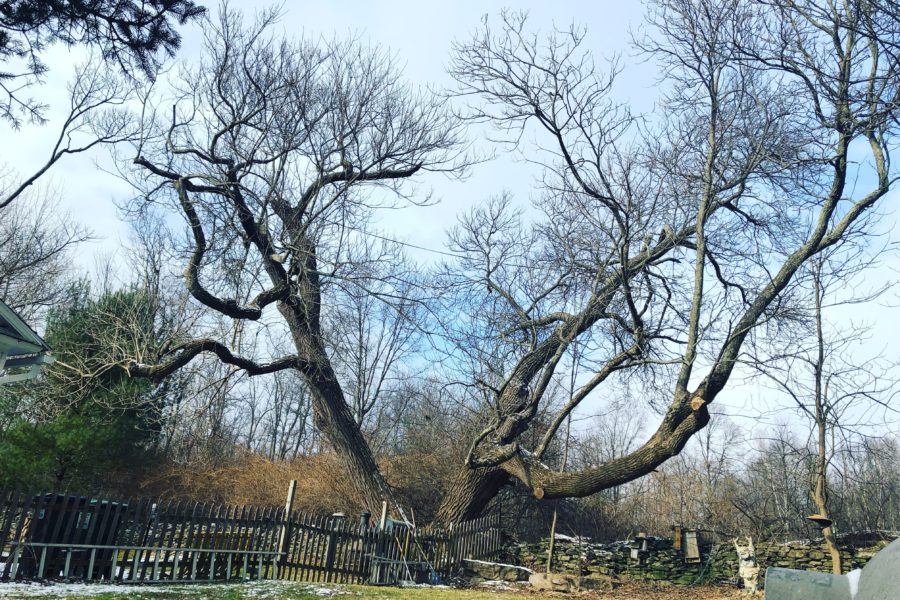Catalpa speciosa.
Sometimes I feel no more lucky than a fart in the wind. But I guess you could say that all depends on which way the wind is blowing.
The Northern Catalpa tree, if trees could tell stories, would certainly be well versed. It is a broad, showy tree that is messy with litter and a certain inseparable stitch from the ecosystem. Pollinators and host specific defoliators are in no shortage under this great crown of crooked, sweeping branches. The long, cigar-like seed pods cast a heavy crop, and they are reason for one common name: Indian cigar tree. It seems to have come from the midwest, and more particularly out of the Victorian era.
Michael Dirr tells us that the Catalpa has an “inherent toughness and adaptability,” (Dirr, 80). Great qualities if you ask me.
The Catalpa is a specimen through and through. And if the one I had stumbled across was cast out of the Victorian period, then certainly it was a Connecticut Yankee in King Arthur’s Court.
I had received a lead in a text. Something to the effect of, “call so and so, here’s the #, here’s the address, already got $ from bucket truck.” Just before I could roll my eyes, I wondered why would I want to waste my time with a lead like that? In competition like that? Blah, blah, blah. But where’s the adventure in that?
I don’t know, maybe it was fate, or timing or whatever, but I gave a ring to see if I could get involved with this tree just for the heck of it. Maybe I could give up on being so indulged with a comfortable taste on things and throw my hat in the ring, throw a little fuel on the old fire, a little sauce on the wings. After all, winter was already here, and any work is better than nothing.
After all that emotional hype, I finally pulled up to the property to meet with the homeowners and pay homage to the great and mysterious tree. I knew what I was looking for as I weaved my way along the country road, past the endless rolling Pennsylvania mountains. And to my enjoyment I saw the great limbs unfurl behind the old farmhouse as I came creeping up the road. An unseasonably warm gust rushed into the frame and I could see the old tree was reaching out happily in every direction. As if it’s space in the world was made just for it. The old Catalpa was a tree with a history of the countryside, of loss and failure and growth in so many senses, a story you could easily drive by and forget, or miss altogether.
Old, failed limbs lay atop the roots breaking down the barriers between earth and sky. A perfect reminder that loss is a part of growth, and what we loose is really never far away.
Two massive, co-dominant stems came steaming out of a volcanic root flare. Above grade between each stem there was some separation where roots that had once been engulfed in the rhizosphere sometime leading out of the Victorian-era were now encased in bark, doomed for a life above ground as aerial roots covered in bark, no longer charged with the task up uptake, but rather, support. This wide, buttressed root crown bore the weight of the entire kingdom above it. From leaf to flower to fruit, one mighty trunk next to another seemingly held the weight of the world and then some.
Old static cables dangled from each stem because lags blew long ago. This Catalpa slumbered over an old rock wall at the edge of the yard like a tired old man. Several large tops had been taken out some time ago, probably in the same visit the cables were set too low in the aging sage. And just as I was taking in all of these small details, the client asked hopefully: “do you think it can be saved?”
I often wonder what’s worth saving and what isn’t. What things are important and what things aren’t. This is a highly subjective matter of course, but in the context of old trees we are dealing with several lifetimes of stories, histories, memories and journeys. In some instances, more than half the canon of American History with small glimpses into the rest of the world at large.
I think the ethical decision comes down to me and to you. Managing trees more often than not is an exploration in character. The arborist thinks deeply in their mind and in their soul about what is right, and about what is possible, and what can potentially fall in line with our techniques and tools and standards. But the owner of the tree many times has a life entwined much more tightly with the life of the tree, although they may not know it just yet. In the morning they wake up to see the silhouette of a scaffold limb against a painted sky, or the smell of fragrant blossom upon the breeze. The tree is a part of them. Everyday nature is created and falls apart all in the same breath, and trees are a perfect example of this. But the arborist is caught in between these moments of recognition, in a gray area where hope and doubt mingle. For it is no easy task to make decisions in a story where we may happen to only be passing through for a moment.
Just before I could answer I accidentally broke wind before the owner and felt slightly embarrassed in my lack of control over such a slightly powerful moment.
“This is definitely a tree worth saving,” I said.
And so the story goes.






Leave a Reply
Your email is safe with us.